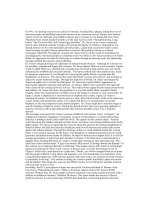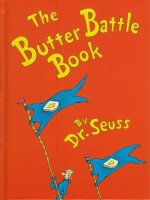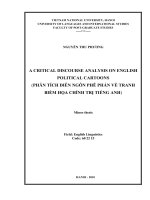dr seuss political cartoons 1198
Bạn đang xem bản rút gọn của tài liệu. Xem và tải ngay bản đầy đủ của tài liệu tại đây (38.45 KB, 2 trang )
In 1941, war loomed around every corner of America. It lurked like a plague, taking the lives of
innocent people and instilling hatred and mistrust in the American society. Homes were broken,
careers were lost, and hope soon faded as tension grew overseas. It was during this time when
Theodore Seuss Geisel decided to battle evil the only way he could through drawing. Long
before "The Cat in the Hat" and "Green Eggs and Ham", Dr. Seuss, as he is most commonly
known, drew political cartoons in hopes of restoring the dignity of America. Although he was
already famous for his witty pesticides advertisements, a giant leap occurred in Seuss's career
when his anger towards Nazism caused him to send his first political cartoon to a liberal
newspaper called PM. Through his cartoons, Dr. Seuss tried to rid the world of wickedness by
encouraging the American people to contribute to the war effort .In Dr. Seuss's portrayal of Adolf
Hitler, his opposition towards the Nazi party is evident through his drawing style, the underlying
messages behind the cartoons, and symbolism.
Dr. Seuss's unique drawing style illustrates his hatred towards Nazism. Although he is known for
his loveable, rounded and floppy-like cartoons, Dr. Seuss depicts Hitler in a cruel manner. Figures
4 and 5 exhibit Hitler as a chiseled chin, arrogant man. His head is high and his eyes are closed,
indicating his snobbish and conceited attitude. The harsh crooked lines that detail his face mark
his pompous expression. It is as though he is showing the public that he is greater than the
foundations of America. This shows the reader that Hitler is aware of his power, and in doing so,
makes the reader loathe the image. Through this depiction of Hitler, Dr. Seuss encourages the
American public not to let him feel that pride. Dr. Seuss also mocks Hitler's appearance by
drawing his signature mustache and hairstyle. As always, Hitler's hair is parted to the right side
with a stand of hair coming down his left eye. This makes Hitler appear boyish instead of powerful
and ruthless. Dr. Seuss also draws his mustache in a way that makes Hitler resemble Charlie
Chaplin. These two characteristics of Hitler convey the image as comedic as well as powerful. In
figure 3, Hitler is depicted as a cross between an elephant and a snake. Again, Dr. Seuss is
mocking his nature. An elephant can be seen as a slow, dim-witted creature while as the snake has
a more sneaky and treacherous nature. It is evident that these two animals alike are not the
brightest, or the most respected in the animal kingdom. Dr. Seuss might have used this image to
ease the feelings of fright in society. During this period of time, fear was a growing epidemic in
America. However, this image demonstrates that America shouldn't cower over a brainless
dictator.
The messages conveyed in Dr. Seuss's cartoons exhibit his anti-Nazism views. In Figure 1, he
emphasizes America's negligence of countries overseas. In this picture, a woman representing
America is holding a book called Adolf the Wolf. The caption in this cartoon states: "And the
wolf chewed up the children and spit out their bones but those were foreign children and it really
didn't matter". Dr. Seuss is expressing his concerns about the innocent lives being slaughtered on
behalf of Hitler. He feels that America should put aside its self interests and instead take action
against the ruthless dictator. Through his drawings of the two small children beside this woman,
Seuss is conveying a message for the future. It as though he is urging his generation not to instill
ignorance and hatred in the minds of children. In order for history not to repeat itself, it is vital for
younger generations to learn from past mistakes. In Figure 2, the Nazi party is represented by a
gigantic beast. Hauling this beast in a cage is a bald eagle wearing its stars and stripes hat. The
catch line of this cartoon states: "Cages cost money! Buy more US Savings Bonds and Stamps!" In
this cartoon, he is implying that there is still hope. This image conveys that America will triumph
against evil and put the Nazis in jail. Justice, in Seuss's eyes, is not far from being served. In
Figure 6, Hitler tells a man dressed as a palm tree: "Shultz, you will be dropped from an air plane
into the jungle of Brazil. Using charm and ingenuity, you will immediately woo and marry some
young Brazilian palm tree. With advance ground-work such as this, my invasion of South America
is practically in the bag". This cartoon is telling the America public that Hitler's plans are unwise
and far fetched. This image also conveys that Hitler's tactics are not full proof, and that America
will soon find victory in war.
Inevitably, the Dr.'s prescription of hope was successful. Professor Richard H. Minear of the
University of Massachusetts states: "Hitler is the prime subject of all of Dr. Seuss's WWII
cartoons. Without him, Dr. Seuss might well have remained a successful commercial artist with a
sideline in children's literature" (Political Dr.Seuss). This quote marks the success of Seuss's
political cartoons. It was his drawings of Hitler that made him a renowned political cartoonist.
These cartoons lifted the spirits of many people in the 1940s. Many people found these cartoons to
be encouraging, and its comical elements served as relief during rough times.
The symbols within Dr. Seuss's political cartoons demonstrate his wrath towards Hitler and his
party. In figure 2, a gigantic creature bearing the Nazi sign represents Hitler's party. The beast has
a foolish look about him, which makes the reader come to the conclusion that all Nazis are stupid
and vulnerable. Again, this comedic representation of Nazis is conveying that there is nothing to
fear. This beast in imprisoned, and is being dragged by the American bald eagle which represents
American victory. This image illustrates that America will not be defeated by evil forces. The
smile upon the bald eagle indicates that America's pride will not be shattered and that happiness
will once again, be restored. In figure 6, the man dressed as a palm tree represents Hitler's
downfall. The plan of action described in this cartoon tells the reader that Hitler will no longer
triumph in his plans of world domination. It also conveys that Hitler is becoming vulnerable due
to the fact that he is running out of clever ideas.
In conclusion, it is evident that Dr. Seuss's political cartoons reflect his feelings towards Nazism.
Through his drawings he tried to relieve the world of the malice that Hitler created. Through his
various symbolisms, drawing techniques and underlying messages, his wrath towards Hitler and
his party are expressed. War has the power to change lives, to take lives, and in many cases to
inspire lives just as it did for Dr. Seuss. In many cases, war isn't the end, it's the beginning of
many things yet to come. The opposite of war is not peace, its creation.
Illustrations that I used:
Figure 1 />Figure 2 />Figure 3 />Figure 4 />Figure 5 />Figure 6 />









